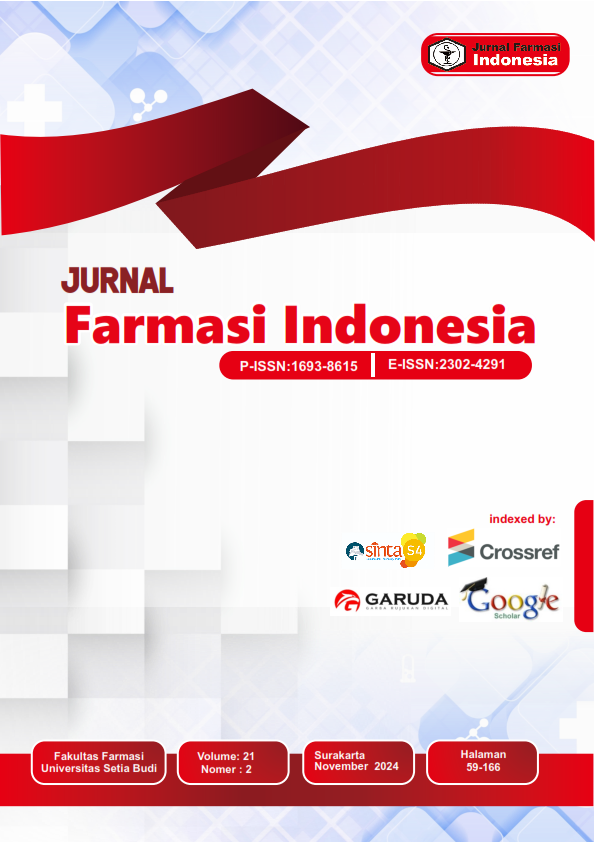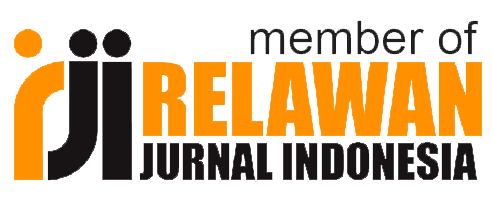Utilization of Averrhoa bilimbi, Orange Peel, and Spinach Waste as a Source of Organic Acids: A Study on Acid Concentration and Potential as a Reducing Agent
Abstract
Fruit and vegetable waste contains organic acids that can still be utilized, offering new potential as reducing agents in environmentally friendly chemical applications. The samples used in this study include Averrhoa bilimbi, orange peel, and spinach waste, known to contain organic acids. This study aims to optimize the extraction process of organic acids from these samples and identify their potential as reducing agents. The method involves drying and dissolving the waste samples, which were dried at 60°C and then disbanded in aquabidest with varying times and temperatures. The concentration of organic acids was analyzed using alkalimetry and permanganometry to measure total acids and reduce acids. The results show that variations in dissolution time and temperature influence the concentration of dissolved organic acids in the waste samples. The highest concentration was achieved at a dissolution time of 90 minutes and a temperature of 60°C, with concentrations decreasing at longer times and higher temperatures. Qualitative identification indicates that Averrhoa bilimbi and spinach contain oxalic and ascorbic acids, while orange peel contains citric and ascorbic acids. These findings highlight the potential of these samples as reducing agents, especially under optimal dissolution conditions.
References
[2] F. Fahrudin, D. R. Haribowo, F. Hamida, H. I. Wardhana, and F. Mirliana, “Aktivitas Herbal Antidepresan Kombinasi Biji Salak dan Kulit Jeruk Terhadap Mencit yang Diperlakukan Tail Suspension Test (TST),” J. Biotek Medisiana Indones., vol. 10, no. 2, pp. 143–154, 2022, doi: 10.22435/jbmi.v10i2.5827.
[3] A. Deasy Rosita Dewi, “Aktivitas Antioksidan Dan Antibakteri Ekstrak Kulit Jeruk Manis (Citrus sinensis) Dan Aplikasinya Sebagai Pengawet Pangan,” J. Teknol. dan Ind. Pangan, vol. 30, no. 1, pp. 83–90, 2019, doi: 10.6066/jtip.2019.30.1.83.
[4] R. Wiradimadja, W. Tanwiriah, and D. Rusmana, “Effect of starfruit (Averrhoa bilimbi L.) giving in the diet on the performance, carcass and income over feed cost native chicken,” Ziraa’ah, vol. 40, no. 2, pp. 86–92, 2015.
[5] H. Fitriani, N. Nurlailah, and D. Rakhmina, “Kandungan Asam Oksalat Sayur Bayam,” Med. Lab. Technol. J., vol. 2, no. 2, p. 51, 2016, doi: 10.31964/mltj.v2i2.95.
[6] H. Fitriani, N. Nurlailah, and D. Rakhmina, “Kandungan Asam Oksalat Sayur Bayam,” Med. Lab. Technol. J., vol. 2, no. 2, pp. 51–55, 2016.
[7] A. Puspitasari and A. Mahayana, “Determination of Oxalid Acid in Green Spinach (Amaranthus Gangeticus) An Red Spinach (Amaranthus Spinousus) Using Spectrophotometry Method,” Jurnal Kimia dan Rekayasa, vol. 2, no. 1. pp. 32–38, 2021. doi: 10.31001/jkireka.v2i1.24.
[8] R. Nurlaila, A. Muarif, M. Meriatna, M. Masrullita, and I. Ishak, “Pengaruh Suhu dan Waktu Ekstraksi dalam Proses Pembuatan Pektin dari Kulit Buah Sukun dengan Pelarut Asam Sitrat,” J. Sci. Appl. Technol., vol. 7, no. 2, p. 65, 2023, doi: 10.35472/jsat.v7i2.1105.
[9] Miksusanti, Elfita, and S. Hotdelina, “Aktivitas Antioksidan dan Sifat Kestabilan Warna Campuran Ekstrak Etil Asetat Kulit Buah Manggis (Garcinia mangostana L.) dan Kayu Secang (Caesalpinia sappan L.),” J. Penelit. Sains, vol. 15, no. 2, pp. 60–69, 2012.
[10] N. W. A. Yuliantari, I. W. R. Widarta, and I. D. G. M. Permana, “Pengaruh Suhu dan Waktu Ekstraksi Terhadap Kandungan Flavonoid dan Aktivitas Antioksidan Daun Sirsak (Annona muricata L.) Menggunakan Ultrasonik The Influence of Time and Temperature on Flavonoid Content and Antioxidant Activity of Sirsak Leaf (Annona mur,” Media Ilm. Teknol. Pangan, vol. 4, no. 1, pp. 35–42, 2017.
[11] R. P. Putri, E. T. Wahyuni, and A. Suratman, “Pengaruh Asam Askorbat dan Asam Oksalat Pada Reduksi Ion Au(III) Oleh Adanya Sinar UV,” Universitas Gadjah Mada, 2016.
[12] A. Adawiah, D. Sukandar, and A. Muawanah, “Aktivitas Antioksidan dan Kandungan Komponen Bioaktif Sari Buah Namnam,” J. Kim. Val., vol. 1, no. November, pp. 130–136, 2015, doi: 10.15408/jkv.v0i0.3155.
[13] M. Muzaifa, “Perubahan Komponen Kimia Belimbing Wuluh (Averrhoa bilimbi L.) Selama Pembuatan Asam Sunti,” J. Teknol. Pertan. Andalas, vol. 22, no. 1, p. 37, 2018, doi: 10.25077/jtpa.22.1.37-43.2018.
[14] A. Aseptianova and E. H. Yuliany, “Penyuluhan Manfaat Belimbing Wuluh (Averrhoa bilimbi Linn.) sebagai Tanaman Kesehatan di Kelurahan Kebun Bunga, Kecamatan Sukarami, Palembang,” Abdihaz J. Ilm. Pengabdi. pada Masy., vol. 2, no. 2, p. 52, 2020, doi: 10.32663/abdihaz.v2i2.910.
[15] T. W. Kurniawan and W. Deglas, “Pemanfaatan Kulit Buah Jeruk Mandarin (Citrus reticulata) Dalam Pembuatan Permen Jelly Dengan Variasi Konsentrasi Bubuk Agar,” Agrofood, vol. 1, no. 2, pp. 1–5, 2019.
[16] Yulianis et al., “Analisa Vitamin C Kulit Jeruk Manis (Citrus Sinensis (L.) Osbeck) dengan Spektrofotometri Uv-Visible,” J. Katalisator, vol. 3, no. 2, pp. 135–144, 2020.
[17] et al., “Changes in postharvest quality of organic spinach during storage after heatshock and hydrocooling treatment,” J. Keteknikan Pertan., vol. 04, no. 1, pp. 53–58, 2016, doi: 10.19028/jtep.04.1.53-58.
[18] F. Khan, M. Shariq, M. Asif, M. A. Siddiqui, P. Malan, and F. Ahmad, “Green Nanotechnology: Plant-Mediated Nanoparticle Synthesis and Application,” Nanomaterials, vol. 12, no. 4, 2022, doi: 10.3390/nano12040673.
[19] F. Rodríguez-Félix et al., “Trends in Sustainable Green Synthesis of Silver Nanoparticles Using Agri-Food Waste Extracts and Their Applications in Health,” J. Nanomater., vol. 2022, 2022, doi: 10.1155/2022/8874003.
[20] A. G. Demesa, S. Saavala, M. Pöysä, and T. Koiranen, “Overview and Toxicity Assessment of Ultrasound-Assisted Extraction of Natural Ingredients from Plants,” Foods, vol. 13, no. 19, pp. 1–13, 2024, doi: 10.3390/foods13193066.













